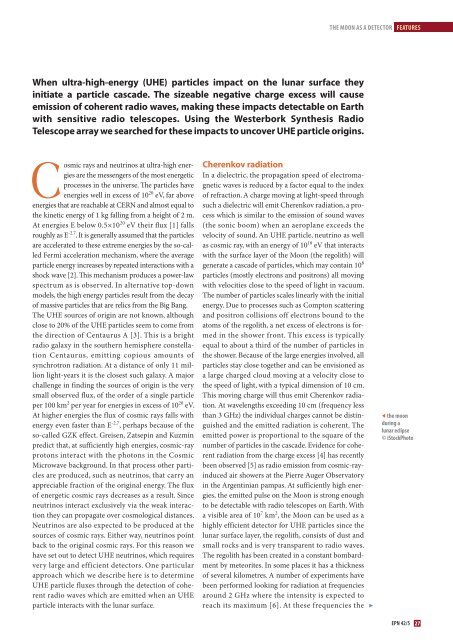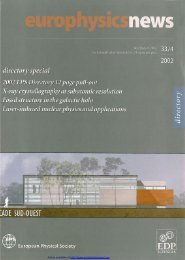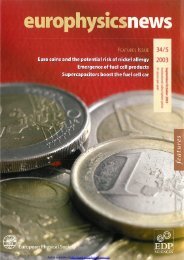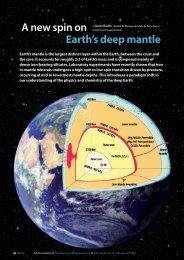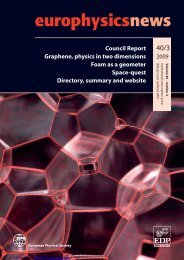PDF (11.37 MB) - Europhysics News
PDF (11.37 MB) - Europhysics News
PDF (11.37 MB) - Europhysics News
Create successful ePaper yourself
Turn your PDF publications into a flip-book with our unique Google optimized e-Paper software.
When ultra-high-energy (UHE) particles impact on the lunar surface they<br />
initiate a particle cascade. The sizeable negative charge excess will cause<br />
emission of coherent radio waves, making these impacts detectable on Earth<br />
with sensitive radio telescopes. Using the Westerbork Synthesis Radio<br />
Telescope array we searched for these impacts to uncover UHE particle origins.<br />
osmic rays and neutrinos at ultra-high energies<br />
are the messengers of the most energetic<br />
processes in the universe. �e particles have<br />
energies well in excess of 1020 eV, far above<br />
energies that are reachable at CERN and almost equal to<br />
the kinetic energy of 1 kg falling from a height of 2 m.<br />
At energies E below 0.5×10 20 eV their flux [1] falls<br />
roughly as E-2.7 . It is generally assumed that the particles<br />
are accelerated to these extreme energies by the so-called<br />
Fermi acceleration mechanism, where the average<br />
particle energy increases by repeated interactions with a<br />
shock wave [2]. �is mechanism produces a power-law<br />
spectrum as is observed. In alternative top-down<br />
models, the high energy particles result from the decay<br />
of massive particles that are relics from the Big Bang.<br />
The UHE sources of origin are not known, although<br />
close to 20% of the UHE particles seem to come from<br />
the direction of Centaurus A [3]. This is a bright<br />
radio galaxy in the southern hemisphere constellation<br />
Centaurus, emitting copious amounts of<br />
synchrotron radiation. At a distance of only 11 million<br />
light-years it is the closest such galaxy. A major<br />
challenge in finding the sources of origin is the very<br />
small observed flux, of the order of a single particle<br />
per 100 km 2 per year for energies in excess of 1020 eV.<br />
At higher energies the flux of cosmic rays falls with<br />
energy even faster than E-2.7 C<br />
, perhaps because of the<br />
so-called GZK effect. Greisen, Zatsepin and Kuzmin<br />
predict that, at sufficiently high energies, cosmic-ray<br />
protons interact with the photons in the Cosmic<br />
Microwave background. In that process other particles<br />
are produced, such as neutrinos, that carry an<br />
appreciable fraction of the original energy. The flux<br />
of energetic cosmic rays decreases as a result. Since<br />
neutrinos interact exclusively via the weak interaction<br />
they can propagate over cosmological distances.<br />
Neutrinos are also expected to be produced at the<br />
sources of cosmic rays. Either way, neutrinos point<br />
back to the original cosmic rays. For this reason we<br />
have set out to detect UHE neutrinos, which requires<br />
very large and efficient detectors. One particular<br />
approach which we describe here is to determine<br />
UHE particle fluxes through the detection of coherent<br />
radio waves which are emitted when an UHE<br />
particle interacts with the lunar surface.<br />
Cherenkov radiation<br />
In a dielectric, the propagation speed of electromagnetic<br />
waves is reduced by a factor equal to the index<br />
of refraction. A charge moving at light-speed through<br />
such a dielectric will emit Cherenkov radiation, a process<br />
which is similar to the emission of sound waves<br />
(the sonic boom) when an aeroplane exceeds the<br />
velocity of sound. An UHE particle, neutrino as well<br />
as cosmic ray, with an energy of 10 18 eV that interacts<br />
with the surface layer of the Moon (the regolith) will<br />
generate a cascade of particles, which may contain 10 8<br />
particles (mostly electrons and positrons) all moving<br />
with velocities close to the speed of light in vacuum.<br />
The number of particles scales linearly with the initial<br />
energy. Due to processes such as Compton scattering<br />
and positron collisions off electrons bound to the<br />
atoms of the regolith, a net excess of electrons is formed<br />
in the shower front. This excess is typically<br />
equal to about a third of the number of particles in<br />
the shower. Because of the large energies involved, all<br />
particles stay close together and can be envisioned as<br />
a large charged cloud moving at a velocity close to<br />
the speed of light, with a typical dimension of 10 cm.<br />
This moving charge will thus emit Cherenkov radiation.<br />
At wavelengths exceeding 10 cm (frequency less<br />
than 3 GHz) the individual charges cannot be distinguished<br />
and the emitted radiation is coherent. The<br />
emitted power is proportional to the square of the<br />
number of particles in the cascade. Evidence for coherent<br />
radiation from the charge excess [4] has recently<br />
been observed [5] as radio emission from cosmic-rayinduced<br />
air showers at the Pierre Auger Observatory<br />
in the Argentinian pampas. At sufficiently high energies,<br />
the emitted pulse on the Moon is strong enough<br />
to be detectable with radio telescopes on Earth. With<br />
a visible area of 10 7 km 2 , the Moon can be used as a<br />
highly efficient detector for UHE particles since the<br />
lunar surface layer, the regolith, consists of dust and<br />
small rocks and is very transparent to radio waves.<br />
The regolith has been created in a constant bombardment<br />
by meteorites. In some places it has a thickness<br />
of several kilometres. A number of experiments have<br />
been performed looking for radiation at frequencies<br />
around 2 GHz where the intensity is expected to<br />
reach its maximum [6]. At these frequencies the<br />
THe moon aS a deTeCTor feaTureS<br />
�<br />
� the moon<br />
during a<br />
lunar eclipse<br />
© iStockPhoto<br />
EPN 42/5 27


